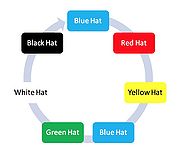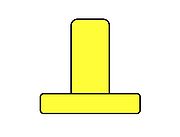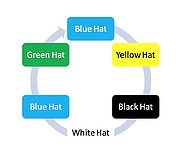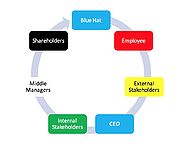Six Thinking Hats
| (21 intermediate revisions by one user not shown) | |||
| Line 1: | Line 1: | ||
| + | ''Developed by Matthew Wells'' | ||
| + | |||
| + | |||
==Overview== | ==Overview== | ||
The ''Six Thinking Hats'' is a group thinking exercise developed by Edward de Bono and was published in 1985. The thinking hats technique, born from the common phrase, 'putting on your thinking cap', is used to structure and plan thinking processes, promote lateral thinking and encourage exploration through brainstorming. It has a broad application across project, program and portfolio management as a facilitation technique used during brainstorming, ideation, conflict resolution, problem solving, and even meeting management. | The ''Six Thinking Hats'' is a group thinking exercise developed by Edward de Bono and was published in 1985. The thinking hats technique, born from the common phrase, 'putting on your thinking cap', is used to structure and plan thinking processes, promote lateral thinking and encourage exploration through brainstorming. It has a broad application across project, program and portfolio management as a facilitation technique used during brainstorming, ideation, conflict resolution, problem solving, and even meeting management. | ||
| − | Six coloured hats, each representing a particular | + | Six coloured hats, each representing a particular mode of thinking (for example: objective, subjective, positive, negative, internal, external), are rotated between during group discussions and meetings, enabling group members to explore these thinking modes in isolation and without influence from other thinking modes. The thinking hats method helps to streamline project, program and portfolio decision making by improving the efficiency and effectiveness of group brainstorming, ideation and discussions. In the context of project, program and portfolio management, effective brainstorming and subsequent decision making is a core competency and is essential at all levels of work. When proper brainstorming, problem solving, meeting management and conflict resolution is facilitated, and the correct tools and techniques are employed, stakeholders and project teams remain engaged, motivated and actively contribute to the success of a project. |
| − | The PMBOK Guide describes the need to develop project charters in order to formally recognise projects, which can arise from business needs, project scope descriptions and/or strategic plans (4.0, PMBOK, 2013). Similarly, PRINCE2 standards highlight that the establishment of a | + | The PMBOK Guide describes the need to develop project charters in order to formally recognise projects, which can arise from business needs, project scope descriptions and/or strategic plans (4.0, PMBOK, 2013). Similarly, PRINCE2 standards highlight that the establishment of a project is a direct response to a project mandate, arising form business needs, unsolved problems or business opportunities (4.3.2, PRINCE2, 2009). Before project charters or mandates can be established, the proper scoping of solutions, benefits and deliverables must take place first, which is where ineffective brainstorming, poor facilitation and improper management can lead projects towards the wrong goals as well as develop and pursue sub-optimal solutions. Project managers can often find it difficult to facilitate discussions between team members and stakeholders, as each group have their own natural ways of thinking, priorities and beliefs, and bringing these perspectives together in a constructive way can be very difficult and counter-productive. |
| − | Both the PMI and PRINCE2 standards acknowledge this by describing the need for brainstorming facilitation tools and techniques, however provide no clear best practice examples. The PMI standards mention the need for tools and techniques "that assist in brainstorming, problem solving, meeting management and conflict resolution" (4.1.2.2, PMBOK, 2013), all throughout the establishment of project management plans, development of project integration management | + | Both the PMI and PRINCE2 standards acknowledge this by describing the need for brainstorming facilitation tools and techniques, however provide no clear best practice examples. The PMI standards mention the need for tools and techniques "that assist in brainstorming, problem solving, meeting management and conflict resolution" (4.1.2.2, PMBOK, 2013), all throughout the establishment of project management plans, when managing process groups and in the development of project integration management. The PMI standards however, provide no clear facilitation tool and techniques to assist "teams and individuals accomplish project activities" (4.1.2.2, PMBOK, 2013). Similarly, within the PRINCE2 standards, business cases which determine how projects are selected are often unstructured, biased and require tools that ensure all possible perspectives and options have been explored in a systematic and structured way. Within the PRINCE2 standards, risk management is the primary driver behind the estimation processes and a report on project management trends published by PriceWaterhouseCoopers in 2012, highlighted that "Poor estimation during the planning phase continues to be the largest contributor to project failures" (The Essential Role of Communications, 2013), stating that 32% of projects failure due to poor planning. PRINCE2 goes further to suggest that a primary risk identification tool and technique is brainstorming, which is "more productive than individual thinking" (8.3.5, Risk management procedure, PRINCE2), however provides no specific tool or techniques to properly address this major issue. |
The Six Thinking Hats method is a tool and technique that will help project managers facilitate brainstorming, ideation and creative thinking across many different perspectives using a structured approach. The thinking hats method can include inputs from all internal organisation levels including external stakeholders, and will allow for a structured and streamlined approach towards an agreed and accepted plan. | The Six Thinking Hats method is a tool and technique that will help project managers facilitate brainstorming, ideation and creative thinking across many different perspectives using a structured approach. The thinking hats method can include inputs from all internal organisation levels including external stakeholders, and will allow for a structured and streamlined approach towards an agreed and accepted plan. | ||
| Line 13: | Line 16: | ||
==Methodology== | ==Methodology== | ||
| − | The underlying principal of the Six Thinking Hats method is parallel thinking, a system where | + | The underlying principal of the Six Thinking Hats method is parallel thinking, a system where groups can discuss different points of view together and without interference from other types of thinking. De Bono believed that the brain could not think critically and make judgements efficiently and effectively because it was constantly analysing from multiple thinking modes and perspectives, simultaneously interpreting, judging, translating, forming, confirming and dismissing (De Bono, 1985). Similarly, the thinking hat method builds upon the theory that chemical balances inside the brain are different when thinking critically, creatively, positively and negatively; and that the brain is ineffective at looking through each lens simultaneously. De Bono believed that by creating a shared common lens for discussion by unbundling each thinking mode and addressing them in structured turns, an entire group can properly discuss all components of an issue effectively and efficiently, creating a transparent cooperative exploration. De Bono acknowledges that his method is not the natural way of thinking for some individuals, but that it enables groups to properly address and investigate all points of view and perspectives in depth and in parallel. In this way, the Six Think Hats method creates a practical method from which to conduct constructive thinking, thereby eliminating adversarial thinking, conflicts and drifting discussions. |
| − | Similarly, the | + | Similarly, the Six Thinking Hat method addresses the pitfalls of adversarial thinking, debate and conflicts within discussions, which can often lead to negative and unproductive work. By eliminating personal attacks and personal bias from ideation, brainstorming and discussions, and by referring to responses as a 'particular type of thinking', (e.g. "That was some interesting red hat thinking"), a simple, effective and impersonal discussion technique is created. |
| − | Finally, the | + | Finally, the Six Thinking Hat method acknowledges that participants of group discussions are unlikely to investigate and pursue topics, ideas and solutions that they do not instinctively like or agree with, leading towards sub-optimal ideation and decision making. The Six Thinking Hat method removes prejudice, personal opinion and tendencies from group discussions and decision making by ensuring that all members give responses and performances based on the particular colour of the hat they are wearing, responses they might not necessarily naturally give. By challenging the natural thinking mode of individuals through the different hats, discussion members can often find themselves challenged, persuaded and even convinced of ideas, topics and solutions that they would not naturally have decided themselves. |
==Method== | ==Method== | ||
| Line 23: | Line 26: | ||
[[File:HatsMethod.jpeg|thumb|right|alt=A draft chart.|Six Thinking Hats Process Diagram]] | [[File:HatsMethod.jpeg|thumb|right|alt=A draft chart.|Six Thinking Hats Process Diagram]] | ||
| − | + | When implementing the Six Thinking Hats method, the blue hat should always start and end the process, as this establishes a clear process of the how to think, organise, summarise the decisions made and record conclusions. Other thinking hats can then be applied in any order, and repeated if necessary, depending on the particular focus within the project, program or portfolio management. | |
The general method of approach for this technique is as follows: | The general method of approach for this technique is as follows: | ||
| − | Step 1. Start the group discussion, feedback or ideation session using the blue hat to open up and organise the group thinking process, how it works, what is the focus and what the intended outcome is. | + | '''Step 1.''' Start the group discussion, feedback or ideation session using the blue hat to open up and organise the group thinking process, how it works, what is the focus and what the intended outcome is. |
| − | Step 2. Place or hold up a coloured marker or 'hat' so that it is visible for all members of the discussion to see. Everyone in the discussion must now address the topic using that particular lens, focus or perspective (see below for each colour and the respective lens profile). | + | '''Step 2.''' Place or hold up a coloured marker or 'hat' so that it is visible for all members of the discussion to see. Everyone in the discussion must now address the topic using that particular lens, focus or perspective (see below for each colour and the respective lens profile). |
| − | Step 3. Rotate through each member of the group one by one to hear their views, thoughts, opinions and responses until everyone has contributed. | + | '''Step 3.''' Rotate through each member of the group one by one to hear their views, thoughts, opinions and responses until everyone has contributed. |
| − | Step 4. Change the coloured marker or 'hat' to another colour and repeat Step 3 until all the coloured hats have been used at least once. | + | '''Step 4.''' Change the coloured marker or 'hat' to another colour and repeat Step 3 until all the coloured hats have been used at least once. |
| − | Step 5. End the brainstorming, ideation, group discussion or feedback session using the blue hat to close the group thinking process, summarise the key takeaways, decisions and next steps. | + | '''Step 5.''' End the brainstorming, ideation, group discussion or feedback session using the blue hat to close the group thinking process, summarise the key takeaways, decisions and next steps. |
| − | It is not mandatory to use all of the coloured thinking hats during each session, only the ones necessary to facilitate the brainstorming, discussion or | + | It is not mandatory to use all of the coloured thinking hats during each session, only the ones necessary to facilitate the brainstorming, discussion or perspective. Each different 'mode' of thinking and respective colour is outlined below. Examples of how these hats can be structured and tailored towards specific brainstorming, ideation and project management activities can be seen below in the Application / Uses section. |
===Red Hat=== | ===Red Hat=== | ||
| Line 57: | Line 60: | ||
[[File:YellowHat1.jpeg|thumb|right|alt=A draft chart.|Yellow Hat]] | [[File:YellowHat1.jpeg|thumb|right|alt=A draft chart.|Yellow Hat]] | ||
| − | The yellow hat is used to explore the optimistic perspective of a project, program or portfolio. The wearer will be optimistic and always think about the benefits. Typically the wearer will try to identify the positive aspects of the project, program or portfolio and will provide logical reasoning for them. Yellow hat thinkers are also seeking harmony within the discussion. | + | The yellow hat is used to explore the optimistic perspective of a project, program or portfolio. The wearer will be optimistic and always think about the benefits. Typically, the wearer will try to identify the positive aspects of the project, program or portfolio and will provide logical reasoning for them. Yellow hat thinkers are also seeking harmony within the discussion. |
Typical questions asked by yellow hat wearers: | Typical questions asked by yellow hat wearers: | ||
| Line 133: | Line 136: | ||
[[File:StrategicPlanning.jpeg|thumb|right|alt=A draft chart.|Example: Strategic Planning Process Diagram]] | [[File:StrategicPlanning.jpeg|thumb|right|alt=A draft chart.|Example: Strategic Planning Process Diagram]] | ||
| − | + | The Six Thinking Hats method can be applied to a diverse range of situations spanning from ideation, brainstorming, problem solving, meeting management to conflict resolution, however the most traditional applications are found within ideation and brainstorming. The traditional applications of this method are extremely useful to project managers as they can analyse business problems or customer needs with a methodology that systematically and rigorously explores all components of the problem or need. | |
| + | |||
| + | Furthermore, with six clear and different thinking modes established, distinct thinking strategies can then be applied to different stages or activities within project, program and portfolio management. Some examples of brainstorming and ideation examples set out originally within De Bono's book include: | ||
'''Initial Ideas''' – Blue, White, Green, Blue | '''Initial Ideas''' – Blue, White, Green, Blue | ||
| Line 145: | Line 150: | ||
'''Strategic Planning''' – Blue, Yellow, Black, White, Blue, Green, Blue | '''Strategic Planning''' – Blue, Yellow, Black, White, Blue, Green, Blue | ||
| − | '''Process Improvement''' – Blue, White, White (Other | + | '''Process Improvement''' – Blue, White, White (Other people's views), Yellow, Black, Green, Red, Blue |
'''Solving Problems''' – Blue, White, Green, Red, Yellow, Black, Green, Blue | '''Solving Problems''' – Blue, White, Green, Red, Yellow, Black, Green, Blue | ||
| Line 157: | Line 162: | ||
1. Creates awareness of multiple perspectives and points of view | 1. Creates awareness of multiple perspectives and points of view | ||
| − | 2. Creates a safe space to discuss issues without | + | 2. Creates a safe space to discuss issues without prejudice |
3. Enables mechanisms to switch gears and thinking | 3. Enables mechanisms to switch gears and thinking | ||
| − | 4. Promotes | + | 4. Promotes focused thinking |
5. Improves communication | 5. Improves communication | ||
| Line 171: | Line 176: | ||
==Limitations == | ==Limitations == | ||
| − | The methodology behind the Six Thinking Hats thinking method, whilst sound and with many successful applications in history (notably Speedo in 2009 after their swimsuits were banned post the 2008 Summer Olympics), has several limitations. The process is very time consuming and involves significant preparation as participants may | + | The methodology behind the Six Thinking Hats thinking method, whilst sound and with many successful applications in history (notably Speedo in 2009 after their swimsuits were banned post the 2008 Summer Olympics), has several limitations. The process is very time consuming and involves significant preparation as participants may be unfamiliar with the task and may need to be guided through the process. Similarly, the amount of time spent with each hat should be monitored and limited as the majority of thinking modes, 'hats', will not be a natural mode of thinking for the participants and some participants may feel uneasy and uncomfortable during the process, which can potentially lead to counter-productivity. Furthermore, participants will each have their preferred brainstorming technique and working rhythm, and may feel more comfortable performing the activity alone as opposed to an open group forum in front of peers and other organisational levels. Finally, as the thinking hats technique is conducted in an open discussion setting, conflicts may arise between competing and differing perspectives, hindering the technique and often leading to tension and counter-productivity. |
==Reflections== | ==Reflections== | ||
| − | Whilst the Six Thinking Hats methodology has several limitations, the PMI and PRINCE2 standards offer no specific tool or technique to help facilitate ideation, brainstorming, problem solving and decision making around developing business cases, project charters or project management plans. Instead, the standards only identify and list the inputs and outputs required for most project management activities and fail to provide any examples of tools and techniques that may aid in this often lengthy process. Because of this, the PMI and PRINCE2 standards currently fail to take into account and ignore the multi-lens and often biased approach many stakeholders have during brainstorming and ideation, which are critical to developing business plans, charters and cases. The Six Thinking Hats method however is one such tool that would contribute towards and complement the current state of the PMI and PRINCE2 standards heavily, as it would provide an appropriate tool from which to properly facilitate structured and | + | Whilst the Six Thinking Hats methodology has several limitations, the PMI and PRINCE2 standards offer no specific tool or technique to help facilitate ideation, brainstorming, problem solving and decision making around developing business cases, project charters or project management plans. Instead, the standards only identify and list the inputs and outputs required for most project management activities and fail to provide any examples of tools and techniques that may aid in this often lengthy process. Because of this, the PMI and PRINCE2 standards currently fail to take into account and ignore the multi-lens and often biased approach many stakeholders have during brainstorming and ideation, which are critical to developing business plans, charters and cases. The Six Thinking Hats method however is one such tool that would contribute towards and complement the current state of the PMI and PRINCE2 standards heavily, as it would provide an appropriate tool from which to properly facilitate structured and unbiased discussion, ideation and decision making. |
| − | Furthermore, other tools also exist that try to structure thinking during the | + | Furthermore, other tools also exist that try to structure brainstorming and decision-making thinking during the establishment of project mandates and project overview statements (POS). One such example closely tied to the PRINCE2 model, however not mentioned within, is the ECPM Framework, which stands for Effective Complex Project Management. The ECPM framework method is comprised of the following components: definition of the problem or business opportunity, a divergent phase, an emergent phase and the convergent phase; and is an effective method because it systematically, robustly and transparently addresses each aspect of the idea within a group setting. An important concept underlying the ECPM framework that helps to promote group discussions without prejudice is that ideas can come from anywhere; "When a group member puts an idea on the table for consideration, they surrender ownership of the idea. It becomes the property of the entire group. It no longer makes any difference where the idea came from, and that should not even be part of any later discussions regarding the idea" (PRINCE2 - A New Brainstorming Model For Client Involvement, 2014). |
| + | |||
| + | In light of the project management standards status quo, and the brainstorming techniques currently available to project managers, the Six Thinking Hat method and similar techniques contribute to the project management body of knowledge and its endeavour to ultimately ensure projects are successful. It would be useful to project managers in the future if such tools and techniques were more heavily referenced, explained and possibly embedded within the standards. | ||
==Modern Interpretations== | ==Modern Interpretations== | ||
| Line 183: | Line 190: | ||
[[File:Alternative2.jpeg|thumb|right|alt=A draft chart.|Example: Company Change Management Process Diagram]] | [[File:Alternative2.jpeg|thumb|right|alt=A draft chart.|Example: Company Change Management Process Diagram]] | ||
| − | Some consultancies have proposed versions that augment the thinking hats into professions (doctor, engineer, lawyer etc), internal company hierarchies (employee, middle level manager, | + | Some consultancies have proposed versions that augment the thinking hats into professions (doctor, engineer, lawyer, accountant, teacher etc), internal company hierarchies (employee, first line manager, middle level manager, officer, CEO, board of directors), stakeholder groups or customer groups. |
==Further Reading== | ==Further Reading== | ||
| − | "The Five Stages of Thinking" is a subsequent tool directly related to the Six Thinking Hats discussion, ideation and decision making method, published by Edward De Bono in 1973. The Five Stages of Thinking was developed for the Cognitive Research Trust (CoRT) Thinking Program | + | "The Five Stages of Thinking" is a subsequent tool directly related to the Six Thinking Hats discussion, ideation and decision-making method, published by Edward De Bono in 1973. The Five Stages of Thinking was developed for the Cognitive Research Trust (CoRT) Thinking Program and further explores the strength of perceptive thinking and how thinking is a skill that can be developed. The Five Stages of Thinking provides a complementary analytical toolkit that correspond to the different thinking hats. For example, yellow hat thinking should use a tool called PMI; standing for plus, minus and interesting. |
==References== | ==References== | ||
| − | A guide to the Project Management Body of Knowledge (PMBOK guide), fifth edition, | + | Project Management Institute, A guide to the Project Management Body of Knowledge (PMBOK guide), fifth edition, 2013, Newtown Square, Project Management Institute, USA |
| − | Managing Successful Projects with PRINCE2, | + | Managing Successful Projects with PRINCE2, 2009, Norwich, The Stationary Office, UK |
| − | De Bono, Edward, | + | De Bono, Edward, 1985, Six Thinking Hats: An Essential Approach to Business Management, Little, Brown, & Company, USA |
| − | + | Wysocki, Robert, Effective Complex Project Management: An Adaptive Agile Framework for Delivering Business Value, 2014, J. Ross Publishing, USA | |
| − | Pulse of the | + | T. L. Saaty, The Analytic Hierarchy Process: Planning, Priority Setting, Resource Allocation, Pittsburgh, RWS Publications, 1996 |
| + | |||
| + | Pulse of the Profession In-Depth Report: The Essential Role of Communications, PMI, 2013 | ||
Insights and Trends: Current Portfolio, Programme, and Project Management Practices, PwC, 2012 | Insights and Trends: Current Portfolio, Programme, and Project Management Practices, PwC, 2012 | ||
| − | + | Morrison, Jim, 2012, June 26, Spanx on Steroids: How Speedo Created the New Record-Breaking Swimsuit, Retrieved from: https://www.smithsonianmag.com | |
| + | |||
| + | Wysocki, Robert, 2014, PRINCE2 - A New Brainstorming Model For Client Involvement, Retrieved from: www.projecttimes.com | ||
==Annotated Bibliography== | ==Annotated Bibliography== | ||
| − | A guide to the Project Management Body of Knowledge (PMBOK Guide Fifth edition) is a set of US based guidelines used in the preparation and management of individual projects and covers a body of project management terminology, vocabulary, frameworks, tools and concepts. The book provides good practices and a set of standards, methods and processes from which to conduct project management activities from. | + | A guide to the Project Management Body of Knowledge (PMBOK Guide Fifth edition) is a set of US based project management guidelines used in the preparation and management of individual projects and covers a body of project management terminology, vocabulary, frameworks, tools and concepts. The book provides good practices and a set of standards, methods and processes from which to conduct project management activities from. The book is robust and detailed in its approach and adequately covers all topics of interest to a project manager. |
PRINCE2 (Projects in a Controlled Environment 2) is a UK project management standards guideline developed in collaboration with academics, project managers/sponsors/teams and with experience from past projects. The guidelines are to be used for anyone wishing to learn the PRINCE2 method for project management and for practitioners of all experience levels. | PRINCE2 (Projects in a Controlled Environment 2) is a UK project management standards guideline developed in collaboration with academics, project managers/sponsors/teams and with experience from past projects. The guidelines are to be used for anyone wishing to learn the PRINCE2 method for project management and for practitioners of all experience levels. | ||
| Line 215: | Line 226: | ||
Spanx on Steroids: How Speedo Created the New Record-Breaking Swimsuit, is a journal article describes how the Speedo brand approached developing a new set of swimwear using a variety of brainstorming techniques including the Six Thinking Hats technique, utilising the green hat for creativity and ideas followed by the black hat to determine the feasibility of each option. | Spanx on Steroids: How Speedo Created the New Record-Breaking Swimsuit, is a journal article describes how the Speedo brand approached developing a new set of swimwear using a variety of brainstorming techniques including the Six Thinking Hats technique, utilising the green hat for creativity and ideas followed by the black hat to determine the feasibility of each option. | ||
| − | Insights and Trends: Current Portfolio, Programme, and Project Management Practices is a report published by PriceWaterhouseCoopers that synthesises responses from 1,524 project management respondents from over 38 countries, spanning the entire organisational hierarchy, regarding project management best | + | Pulse of the Profession In-Depth Report: The Essential Role of Communications is a report commissioned by the US Project Management Institute and presents findings about the correlation between good communication and project success. The report was conducted in 2013, surveyed over 1100 project managers of varying levels of experience across projects with budgets greater than $250,000.00USD. |
| + | |||
| + | Insights and Trends: Current Portfolio, Programme, and Project Management Practices is a report published by PriceWaterhouseCoopers that synthesises responses from 1,524 project management respondents from over 38 countries, spanning the entire organisational hierarchy, regarding project management best practices and current usages. The report links project management success and failures to criteria set out in established project management frameworks and highlights current trends within project execution. | ||
Latest revision as of 17:31, 16 November 2018
Developed by Matthew Wells
Contents |
[edit] Overview
The Six Thinking Hats is a group thinking exercise developed by Edward de Bono and was published in 1985. The thinking hats technique, born from the common phrase, 'putting on your thinking cap', is used to structure and plan thinking processes, promote lateral thinking and encourage exploration through brainstorming. It has a broad application across project, program and portfolio management as a facilitation technique used during brainstorming, ideation, conflict resolution, problem solving, and even meeting management.
Six coloured hats, each representing a particular mode of thinking (for example: objective, subjective, positive, negative, internal, external), are rotated between during group discussions and meetings, enabling group members to explore these thinking modes in isolation and without influence from other thinking modes. The thinking hats method helps to streamline project, program and portfolio decision making by improving the efficiency and effectiveness of group brainstorming, ideation and discussions. In the context of project, program and portfolio management, effective brainstorming and subsequent decision making is a core competency and is essential at all levels of work. When proper brainstorming, problem solving, meeting management and conflict resolution is facilitated, and the correct tools and techniques are employed, stakeholders and project teams remain engaged, motivated and actively contribute to the success of a project.
The PMBOK Guide describes the need to develop project charters in order to formally recognise projects, which can arise from business needs, project scope descriptions and/or strategic plans (4.0, PMBOK, 2013). Similarly, PRINCE2 standards highlight that the establishment of a project is a direct response to a project mandate, arising form business needs, unsolved problems or business opportunities (4.3.2, PRINCE2, 2009). Before project charters or mandates can be established, the proper scoping of solutions, benefits and deliverables must take place first, which is where ineffective brainstorming, poor facilitation and improper management can lead projects towards the wrong goals as well as develop and pursue sub-optimal solutions. Project managers can often find it difficult to facilitate discussions between team members and stakeholders, as each group have their own natural ways of thinking, priorities and beliefs, and bringing these perspectives together in a constructive way can be very difficult and counter-productive.
Both the PMI and PRINCE2 standards acknowledge this by describing the need for brainstorming facilitation tools and techniques, however provide no clear best practice examples. The PMI standards mention the need for tools and techniques "that assist in brainstorming, problem solving, meeting management and conflict resolution" (4.1.2.2, PMBOK, 2013), all throughout the establishment of project management plans, when managing process groups and in the development of project integration management. The PMI standards however, provide no clear facilitation tool and techniques to assist "teams and individuals accomplish project activities" (4.1.2.2, PMBOK, 2013). Similarly, within the PRINCE2 standards, business cases which determine how projects are selected are often unstructured, biased and require tools that ensure all possible perspectives and options have been explored in a systematic and structured way. Within the PRINCE2 standards, risk management is the primary driver behind the estimation processes and a report on project management trends published by PriceWaterhouseCoopers in 2012, highlighted that "Poor estimation during the planning phase continues to be the largest contributor to project failures" (The Essential Role of Communications, 2013), stating that 32% of projects failure due to poor planning. PRINCE2 goes further to suggest that a primary risk identification tool and technique is brainstorming, which is "more productive than individual thinking" (8.3.5, Risk management procedure, PRINCE2), however provides no specific tool or techniques to properly address this major issue.
The Six Thinking Hats method is a tool and technique that will help project managers facilitate brainstorming, ideation and creative thinking across many different perspectives using a structured approach. The thinking hats method can include inputs from all internal organisation levels including external stakeholders, and will allow for a structured and streamlined approach towards an agreed and accepted plan.
[edit] Methodology
The underlying principal of the Six Thinking Hats method is parallel thinking, a system where groups can discuss different points of view together and without interference from other types of thinking. De Bono believed that the brain could not think critically and make judgements efficiently and effectively because it was constantly analysing from multiple thinking modes and perspectives, simultaneously interpreting, judging, translating, forming, confirming and dismissing (De Bono, 1985). Similarly, the thinking hat method builds upon the theory that chemical balances inside the brain are different when thinking critically, creatively, positively and negatively; and that the brain is ineffective at looking through each lens simultaneously. De Bono believed that by creating a shared common lens for discussion by unbundling each thinking mode and addressing them in structured turns, an entire group can properly discuss all components of an issue effectively and efficiently, creating a transparent cooperative exploration. De Bono acknowledges that his method is not the natural way of thinking for some individuals, but that it enables groups to properly address and investigate all points of view and perspectives in depth and in parallel. In this way, the Six Think Hats method creates a practical method from which to conduct constructive thinking, thereby eliminating adversarial thinking, conflicts and drifting discussions.
Similarly, the Six Thinking Hat method addresses the pitfalls of adversarial thinking, debate and conflicts within discussions, which can often lead to negative and unproductive work. By eliminating personal attacks and personal bias from ideation, brainstorming and discussions, and by referring to responses as a 'particular type of thinking', (e.g. "That was some interesting red hat thinking"), a simple, effective and impersonal discussion technique is created.
Finally, the Six Thinking Hat method acknowledges that participants of group discussions are unlikely to investigate and pursue topics, ideas and solutions that they do not instinctively like or agree with, leading towards sub-optimal ideation and decision making. The Six Thinking Hat method removes prejudice, personal opinion and tendencies from group discussions and decision making by ensuring that all members give responses and performances based on the particular colour of the hat they are wearing, responses they might not necessarily naturally give. By challenging the natural thinking mode of individuals through the different hats, discussion members can often find themselves challenged, persuaded and even convinced of ideas, topics and solutions that they would not naturally have decided themselves.
[edit] Method
When implementing the Six Thinking Hats method, the blue hat should always start and end the process, as this establishes a clear process of the how to think, organise, summarise the decisions made and record conclusions. Other thinking hats can then be applied in any order, and repeated if necessary, depending on the particular focus within the project, program or portfolio management.
The general method of approach for this technique is as follows:
Step 1. Start the group discussion, feedback or ideation session using the blue hat to open up and organise the group thinking process, how it works, what is the focus and what the intended outcome is.
Step 2. Place or hold up a coloured marker or 'hat' so that it is visible for all members of the discussion to see. Everyone in the discussion must now address the topic using that particular lens, focus or perspective (see below for each colour and the respective lens profile).
Step 3. Rotate through each member of the group one by one to hear their views, thoughts, opinions and responses until everyone has contributed.
Step 4. Change the coloured marker or 'hat' to another colour and repeat Step 3 until all the coloured hats have been used at least once.
Step 5. End the brainstorming, ideation, group discussion or feedback session using the blue hat to close the group thinking process, summarise the key takeaways, decisions and next steps.
It is not mandatory to use all of the coloured thinking hats during each session, only the ones necessary to facilitate the brainstorming, discussion or perspective. Each different 'mode' of thinking and respective colour is outlined below. Examples of how these hats can be structured and tailored towards specific brainstorming, ideation and project management activities can be seen below in the Application / Uses section.
[edit] Red Hat
The red hat is used to explore the emotional perspective of a project, program or portfolio. The wearer is usually intuitive and instinctive and will usually rely on their gut reactions, feelings, emotions and instincts for the discussion. The wearer will not provide any justification for their responses and can often be persuaded during the course of the discussion as feelings can change.
Typical questions asked by red hat wearers:
What is your first impression of the scenario?
How do you feel about the scenario?
What are your initial thoughts on how to resolve it?
[edit] Yellow Hat
The yellow hat is used to explore the optimistic perspective of a project, program or portfolio. The wearer will be optimistic and always think about the benefits. Typically, the wearer will try to identify the positive aspects of the project, program or portfolio and will provide logical reasoning for them. Yellow hat thinkers are also seeking harmony within the discussion.
Typical questions asked by yellow hat wearers:
What are the strengths/positive points?
What is working well?
How will it help?
What are the benefits / opportunities?
[edit] Blue Hat
The blue hat is used to explore the managing perspective of a project, program or portfolio. It is used to discuss process control and typically the wearer of the blue hat is trying to organise the thinking and plan for action. Blue hat wearers will ask questions of others, ask for summaries, conclusions and decisions.
Typical questions asked by blue hat wearers:
In what order should team members share their perspectives?
What decisions have we reached?
What do we do next from here?
[edit] Green Hat
The green hat is used to explore the creativity perspective of a project, program or portfolio. It is used to enable outside the box thinking and typically the wearer will provoke others and investigate ideas or thoughts. The wearer of the green hat usually comes up with alternatives, ideas and solutions to problems and risks generated by black hat thinking.
Typical questions asked by green hat wearers:
What are some ways to work this out?
What are other ways to solve the problem?
[edit] White Hat
The white hat is used to explore the facts of a project, program or portfolio. The wearer of the white hat will only use available information in their assessments and discussions, and will remain neutral and objective throughout the entire process.
Typical questions asked by white hat wearers:
"What are the facts?"
"What do I know?"
"What do I need to know?"
"How will i get the information I need?"
What is relevant? Important?
[edit] Black Hat
The black hat is used to explore the cautious perspective of a project, program or portfolio. The wearer will typically think of the risks, challenges, obstacles and barriers. The black hat thinker will provide logical reasons for their concerns and is generally conservative, practical and realistic in their responses.
Typical questions asked by black hat wearers:
"Why will this not work?"
"What is wrong?"
"What are the weaknesses / negative points?"
What are the challenges?
[edit] Application / Uses
The Six Thinking Hats method can be applied to a diverse range of situations spanning from ideation, brainstorming, problem solving, meeting management to conflict resolution, however the most traditional applications are found within ideation and brainstorming. The traditional applications of this method are extremely useful to project managers as they can analyse business problems or customer needs with a methodology that systematically and rigorously explores all components of the problem or need.
Furthermore, with six clear and different thinking modes established, distinct thinking strategies can then be applied to different stages or activities within project, program and portfolio management. Some examples of brainstorming and ideation examples set out originally within De Bono's book include:
Initial Ideas – Blue, White, Green, Blue
Choosing between alternatives – Blue, White, (Green), Yellow, Black, Red, Blue
Identifying Solutions – Blue, White, Black, Green, Blue
Quick Feedback – Blue, Black, Green, Blue
Strategic Planning – Blue, Yellow, Black, White, Blue, Green, Blue
Process Improvement – Blue, White, White (Other people's views), Yellow, Black, Green, Red, Blue
Solving Problems – Blue, White, Green, Red, Yellow, Black, Green, Blue
Performance Review – Blue, Red, White, Yellow, Black, Green Red, Blue
[edit] Benefits
The Six Thinking Hats method has many benefits during brainstorming, ideation and problem solving as it enables groups to think in the same direction whilst removing judgement from their responses. Some major benefits of the thinking hat method are:
1. Creates awareness of multiple perspectives and points of view
2. Creates a safe space to discuss issues without prejudice
3. Enables mechanisms to switch gears and thinking
4. Promotes focused thinking
5. Improves communication
6. Improves decision making
7. Improves creativity of solutions
[edit] Limitations
The methodology behind the Six Thinking Hats thinking method, whilst sound and with many successful applications in history (notably Speedo in 2009 after their swimsuits were banned post the 2008 Summer Olympics), has several limitations. The process is very time consuming and involves significant preparation as participants may be unfamiliar with the task and may need to be guided through the process. Similarly, the amount of time spent with each hat should be monitored and limited as the majority of thinking modes, 'hats', will not be a natural mode of thinking for the participants and some participants may feel uneasy and uncomfortable during the process, which can potentially lead to counter-productivity. Furthermore, participants will each have their preferred brainstorming technique and working rhythm, and may feel more comfortable performing the activity alone as opposed to an open group forum in front of peers and other organisational levels. Finally, as the thinking hats technique is conducted in an open discussion setting, conflicts may arise between competing and differing perspectives, hindering the technique and often leading to tension and counter-productivity.
[edit] Reflections
Whilst the Six Thinking Hats methodology has several limitations, the PMI and PRINCE2 standards offer no specific tool or technique to help facilitate ideation, brainstorming, problem solving and decision making around developing business cases, project charters or project management plans. Instead, the standards only identify and list the inputs and outputs required for most project management activities and fail to provide any examples of tools and techniques that may aid in this often lengthy process. Because of this, the PMI and PRINCE2 standards currently fail to take into account and ignore the multi-lens and often biased approach many stakeholders have during brainstorming and ideation, which are critical to developing business plans, charters and cases. The Six Thinking Hats method however is one such tool that would contribute towards and complement the current state of the PMI and PRINCE2 standards heavily, as it would provide an appropriate tool from which to properly facilitate structured and unbiased discussion, ideation and decision making.
Furthermore, other tools also exist that try to structure brainstorming and decision-making thinking during the establishment of project mandates and project overview statements (POS). One such example closely tied to the PRINCE2 model, however not mentioned within, is the ECPM Framework, which stands for Effective Complex Project Management. The ECPM framework method is comprised of the following components: definition of the problem or business opportunity, a divergent phase, an emergent phase and the convergent phase; and is an effective method because it systematically, robustly and transparently addresses each aspect of the idea within a group setting. An important concept underlying the ECPM framework that helps to promote group discussions without prejudice is that ideas can come from anywhere; "When a group member puts an idea on the table for consideration, they surrender ownership of the idea. It becomes the property of the entire group. It no longer makes any difference where the idea came from, and that should not even be part of any later discussions regarding the idea" (PRINCE2 - A New Brainstorming Model For Client Involvement, 2014).
In light of the project management standards status quo, and the brainstorming techniques currently available to project managers, the Six Thinking Hat method and similar techniques contribute to the project management body of knowledge and its endeavour to ultimately ensure projects are successful. It would be useful to project managers in the future if such tools and techniques were more heavily referenced, explained and possibly embedded within the standards.
[edit] Modern Interpretations
Some consultancies have proposed versions that augment the thinking hats into professions (doctor, engineer, lawyer, accountant, teacher etc), internal company hierarchies (employee, first line manager, middle level manager, officer, CEO, board of directors), stakeholder groups or customer groups.
[edit] Further Reading
"The Five Stages of Thinking" is a subsequent tool directly related to the Six Thinking Hats discussion, ideation and decision-making method, published by Edward De Bono in 1973. The Five Stages of Thinking was developed for the Cognitive Research Trust (CoRT) Thinking Program and further explores the strength of perceptive thinking and how thinking is a skill that can be developed. The Five Stages of Thinking provides a complementary analytical toolkit that correspond to the different thinking hats. For example, yellow hat thinking should use a tool called PMI; standing for plus, minus and interesting.
[edit] References
Project Management Institute, A guide to the Project Management Body of Knowledge (PMBOK guide), fifth edition, 2013, Newtown Square, Project Management Institute, USA
Managing Successful Projects with PRINCE2, 2009, Norwich, The Stationary Office, UK
De Bono, Edward, 1985, Six Thinking Hats: An Essential Approach to Business Management, Little, Brown, & Company, USA
Wysocki, Robert, Effective Complex Project Management: An Adaptive Agile Framework for Delivering Business Value, 2014, J. Ross Publishing, USA
T. L. Saaty, The Analytic Hierarchy Process: Planning, Priority Setting, Resource Allocation, Pittsburgh, RWS Publications, 1996
Pulse of the Profession In-Depth Report: The Essential Role of Communications, PMI, 2013
Insights and Trends: Current Portfolio, Programme, and Project Management Practices, PwC, 2012
Morrison, Jim, 2012, June 26, Spanx on Steroids: How Speedo Created the New Record-Breaking Swimsuit, Retrieved from: https://www.smithsonianmag.com
Wysocki, Robert, 2014, PRINCE2 - A New Brainstorming Model For Client Involvement, Retrieved from: www.projecttimes.com
[edit] Annotated Bibliography
A guide to the Project Management Body of Knowledge (PMBOK Guide Fifth edition) is a set of US based project management guidelines used in the preparation and management of individual projects and covers a body of project management terminology, vocabulary, frameworks, tools and concepts. The book provides good practices and a set of standards, methods and processes from which to conduct project management activities from. The book is robust and detailed in its approach and adequately covers all topics of interest to a project manager.
PRINCE2 (Projects in a Controlled Environment 2) is a UK project management standards guideline developed in collaboration with academics, project managers/sponsors/teams and with experience from past projects. The guidelines are to be used for anyone wishing to learn the PRINCE2 method for project management and for practitioners of all experience levels.
Six Thinking Hats: An Essential Approach to Business Management, is the original body of text written by Edward De Bono describing the nature of thinking as a deliberate process, the reasoning behind each coloured hat the ways in which each wearer should think. The book goes on to describe how the hats act as a persona and allow for dialogue that would not naturally occur in verbal conversations. The book further explores the methods of reasoning, the questions and motives behind each coloured hat.
Spanx on Steroids: How Speedo Created the New Record-Breaking Swimsuit, is a journal article describes how the Speedo brand approached developing a new set of swimwear using a variety of brainstorming techniques including the Six Thinking Hats technique, utilising the green hat for creativity and ideas followed by the black hat to determine the feasibility of each option.
Pulse of the Profession In-Depth Report: The Essential Role of Communications is a report commissioned by the US Project Management Institute and presents findings about the correlation between good communication and project success. The report was conducted in 2013, surveyed over 1100 project managers of varying levels of experience across projects with budgets greater than $250,000.00USD.
Insights and Trends: Current Portfolio, Programme, and Project Management Practices is a report published by PriceWaterhouseCoopers that synthesises responses from 1,524 project management respondents from over 38 countries, spanning the entire organisational hierarchy, regarding project management best practices and current usages. The report links project management success and failures to criteria set out in established project management frameworks and highlights current trends within project execution.








